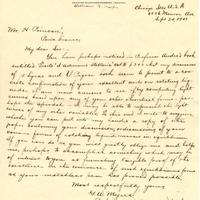George William Myers (1864–1931) was born in Champaign County, Illinois.11If not otherwise indicated, biographical data is from Marquis-Who’s Who (1968, 885). He studied engineering at the University of Illinois. Like many other American students in the exact sciences at the time, he went to Germany to obtain a Ph.D.22For an overview, see Parshall & Rowe (1994). In 1896, he defended a thesis in theoretical astronomy at the University of Munich under Hugo von Seeliger’s direction, on the source of the variability in the Lyræ binary star system.33See Myers (1896), or the summary in English (Myers 1898).
From 1888 to 1900, Myers held several positions in succession at the University of Illinois, from instructor of mathematics to assistant, associate, and full professor of mathematics and astronomy. Upon completion of his thesis in Munich, he directed the new observatory in Urbana. In 1900, Myers became head of astronomy and mathematics at the Chicago Institute, an institution for educating future schoolteachers founded by Francis Wayland Parker (1837–1902), a pioneer of the progressive school movement in the United States. In 1901, the Chicago Institute became the School of Education of the University of Chicago (Dewey 1902), where Myers was named professor of mathematics education and astronomy, a position he held until his retirement in 1929.
Myers was a member of the astronomical societies of Germany, France, Belgium, Mexico and South America, and belonged to the American Academy for the Advancement of Science, and the American Mathematical Society. An author of high-school mathematics texts, and translator of a German text on experimental physics, Myers contributed to theoretical astronomy, which is the subject of his letter to Poincaré in 1901 (Myers à Poincaré - 1901-09-24).
Myers’ letter to Poincaré may have been prompted by the latter’s remark on binary stars of the Lyræ type, inserted in his review of the second volume of Charles André’s Traité d’astronomie stellaire (1900):
Ces étoiles doubles photométriques se répartissent en deux classes, celle d’Algol dont les variations sont discontinues et celle de Lyre dont les variations sont continues. [..] La variabilité des étoiles du type d’Algol paraît due à des éclipses, celle des étoiles du type de la Lyre à l’aplatissement considérable des deux composantes qui, pendant leur rotation et leur révolution orbitale, présenteraient à l’œil de l’observateur tantôt une section faible, tantôt une section considérable. Les premières seraient des systèmes binaires formés, les autres des systèmes binaires en voie de formation. (Poincaré 1901, 44)
Myers’ interest in the Lyræ binary star system stemmed from his doctoral thesis, where he suggested that one star in the system might have the form of Poincaré’s pear-shaped figure of equilibrium. Myers supposed that the system’s cyclical variation of light intensity was the result of “mutual eclipses of two revolving bodies of unequal brightness” (Myers 1898, 4). From observational data and a few convenient assumptions, Myers concluded that the two bodies are ellipsoids of revolution, and that the distance of their centers is only about 2.4 times the semi-major axis of the larger ellipsoid, such that the separation of the two bodies is very small indeed. For Myers, Lyræ “furnishes us a concrete illustration of the actual existence in space of a Poincaré figure of equilibrium” (Myers 1898, 19). Judging from Poincaré’s review of André’s Traité, he found Myers’ suggestion to be quite plausible. He later published Charles Nordmann’s speculation that continuously-varying light intensity from a celestial body results from the orbit of a gaseous pear-shaped figure (Nordmann 1909). Poincaré also allowed for the possibility that binary stars result from the increase in rotational velocity of a rotating fluid mass due to cooling (Poincaré 1911, XV–XVI).
References
- Traité d’astronomie stellaire, Volume 2. Gauthier-Villars, Paris. External Links: Link.
- The University of Chicago School of Education. Elementary School Teacher 3 (3), pp. 200–203.
- Who Was Who in America: A Companion Volume to Who’s Who in America, Volume 1, 1887–1942. Marquis-Who’s Who, Chicago.
- Untersuchungen ueber den Lichtwechsel des Sternes Lyræ. Ph.D. Thesis, Ludwig-Maximilians-Universität zu München, Munich.
- The system of Lyræ. Astrophysical Journal 7, pp. 1–22. External Links: Link.
- L’espace céleste est-il un milieu dispersif?. Bulletin astronomique 26 (1), pp. 5–37. External Links: Link.
- The Emergence of the American Mathematical Research Community, 1876–1900: J.J. Sylvester, Felix Klein, and E. H. Moore. American Mathematical Society and London Mathematical Society, Providence, RI.
- André, Traité d’astronomie stellaire, 2e partie. Bulletin astronomique 18 (1), pp. 42–45. External Links: Link.
- Leçons sur les hypothèses cosmogoniques. Hermann, Paris. External Links: Link.

